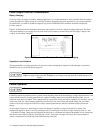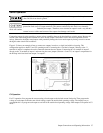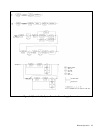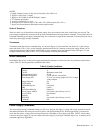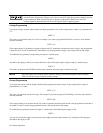
Remote Operation 63
Power-On Service Request (PON)
The power supply can request service from the controller when the power is turned on. This request can be enabled or
disabled by sending a PON command (see page 77). When the request is enabled, the supply can generate an SRQ at
power-on or when there is a momentary loss in power. You can execute a serial poll to clear the service request. Table 5-7
details the conditions under which a PON command will generate an SRQ.
NOTE The power supply has a non-volatile memory in which it stores certain system variables. Some of these
variables are the calibration constants, the present supply address, and the present setting of the PON
command.
Programming Syntax
The following paragraphs describe the syntax of the device command that is used to program your power supply. As shown
in Figure 5-1, the device command is a specific part of the program statement that your computer will accept. The first part
of the statement is computer as well as programming language specific. Figure 5-1 shows the structure of a typical
programming statement for an Agilent Series 200 computer. If you are using a different computer or programming
language, refer to your computer programming manual to determine the correct syntax for this portion of the program
statement. This section of the manual is only concerned with the device command portion (the part inside the quotes for
Series 200 computers with BASIC) of the program statement.
Figure 5-1. Typical Program Statement for Series 200 Computers
Figure 5-2 shows the possible syntax forms for the device commands that are used to program the power supply. Syntax
forms for the calibration commands that are discussed in Appendix A are also included. The oblong shape at the left of the
syntax forms contains the command header which must be entered as shown in Tables 5-1 and 5-2. Commands are accepted
in either uppercase or lowercase letters (ASCII characters). Circles contain characters that must be entered exactly as
shown. Characters such as a space <SP> or a comma are used to separate elements in the command string. Characters such
as a line feed < LF > or a semicolon are used to terminate the command string. Rectangles contain parameters that follow
the command header lines and arrows indicate the correct paths through the syntax diagrams.
Numeric Data
The power supply will accept numeric data in implicit point, explicit point, or scientific notation. A general syntax diagram
for numeric data is included in Figure 5-2. Implicit point notation means that numbers do not contain a decimal point;
integers for example. Numbers written in explicit notation contain a decimal point, such as 12.35. In scientific notation, the
letter E stands for "10 raised to". For example, 1.2E3 is read as 1.2 times 10 raised to the 3rd power, which equals 1,200.
Plus and minus signs are considered numeric characters and are optional. If you program a number with an accuracy that is
greater than the resolution of the supply, the number will automatically be rounded to the nearest multiple of the power
supply’s resolution. Table 5-1 gives the ranges for numeric data that is sent to the supply.
The power supply will also return numeric data (ASCII characters) to your computer. The format of the numbers returned
depends upon the type of data requested. Table 5-2 gives the format for data returned to the computer in response to any of
the queries that are listed.



